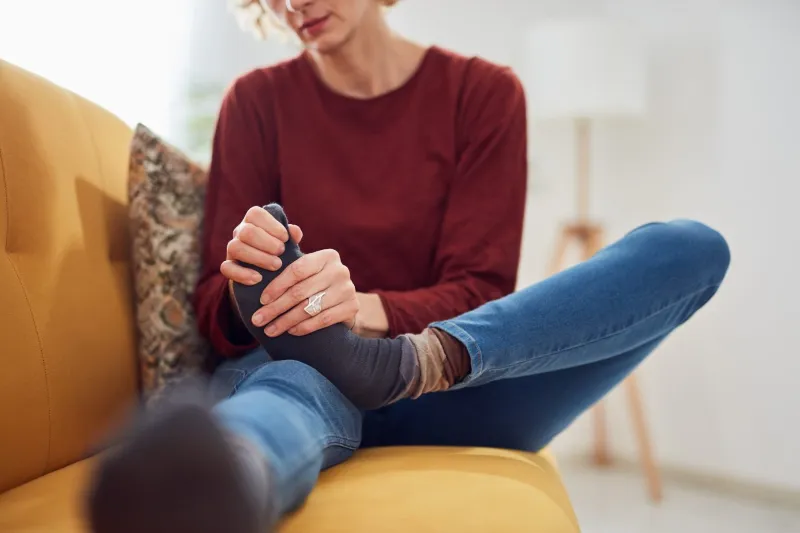CORN TREATMENT
Say goodbye to corn discomfort. Welcome to our expert corn treatment solutions! At MyFootMedic, we’re dedicated to freeing you from corn woes. Discover our effective treatments today!

Services
WHAT ARE CORNS?
Have you ever felt a painful bump on your foot that seems to have developed out of nowhere? Chances are, it might be a corn. Corns are common foot problems that can be quite painful, but with the right knowledge and care, they can be easily treated.
Corns are small, round areas of thickened skin that usually form in response to friction or pressure. You’ll often find them on the tops of your toes, the soles of your feet, or even between your toes. They can be hard, soft, or even tiny seed-like spots, each with its own unique characteristics.
While corns can initially be painless, they can worsen if left untreated. Severe corns can cause considerable discomfort and may even become infected. It’s crucial to address corns promptly to prevent such complications.
‘Seed’ corns, though less common than other types, can be particularly bothersome. They usually develop on the ball of the foot and appear as a cluster of small sores. These types of corns can feel tender and trigger sharp, splinter-like pain. It’s common to mistake seed corns for plantar warts (verrucae), so if you’re unsure, it’s best to see a podiatrist for an accurate diagnosis and appropriate treatment.
WHAT CAUSES CORNS?
Corns are the foot’s way of protesting against repeated pressure and friction. Understanding what causes corns can help you take proactive steps to prevent them.
Ill-Fitting Footwear
One of the primary culprits behind corns is ill-fitting footwear. Shoes that are too tight, have narrow toe boxes, or high heels can exert constant pressure on certain areas of the feet, leading to the development of corns. Orthotics and insoles can help to alter or redistribute pressure whilst you walk.
Foot Deformities
Certain foot deformities, such as hammertoes or bunions, can contribute to the formation of corns. These deformities can cause toes to rub against the inside of the shoes, leading to friction and subsequently, the development of corns.
Walking style
Biomechanics can also play a role in corn formation. Your gait, or the way you walk, may put excess pressure on certain parts of your foot. A biomechanical assessment can help uncover any underlying issues.
High Levels of Physical Activity
Engaging in activities that involve prolonged standing or walking can create constant friction and pressure on the feet, increasing the likelihood of corn formation.
Other Factors
In addition to the above, factors such as age, foot anatomy, and even hereditary predisposition can contribute to the development of corns.
WHAT IS THE BEST CORN TREATMENT?
When dealing with persistent or painful corns, it’s best to seek the expertise of a Podiatrist to accurately diagnose your condition and determine the most effective course of treatment. Understanding the underlying cause of the corns is crucial in offering the most suitable treatment.
A Podiatrist can provide personalised recommendations tailored to your specific condition. Simple interventions such as changing footwear may suffice in some cases, while addressing underlying issues like hammertoes may be necessary for long-term relief.
Home Treatments for Relief
In addition to professional care, there are simple yet effective home treatments that can provide relief and aid in the healing process:
- Soaking the corn in warm water for 10 minutes can soften the skin.
- Gently filing the corn with a pumice stone using circular movements can help reduce its size, but caution should be exercised to prevent excessive skin removal.
- Daily application of moisturising lotion containing 10% urea can help soften the corn.
- Utilising doughnut-shaped corn pads can protect the corn and reduce friction from footwear.
Insoles/Orthotics
Prescription insoles (known as orthotics or orthoses) may be used to redistribute pressure and stop corns from forming, or to address any biomechanical issues that may be leading to the development of corns.
Dermal Fillers
Dermal filler injections are the introduction of a gel-like substance beneath the skin to offer increased cushioning, ease pressure, and replenish lost fatty tissue. These can be used in areas of high pressure to prevent the formation of corns.
Corn Surgery
In acute cases where other treatments have proven ineffective, corn surgery may be recommended. Under local anaesthesia, the corn is surgically excised, and stitches may be used to close the area. Post-surgery, a period of rest and proper wound care will be essential for recovery.
Understanding the range of treatment options, from simple home remedies to professional interventions, can provide reassurance and relief for those dealing with corn-related discomfort. If you’re in need of expert care for your corns, MyFootMedic are here to provide comprehensive treatment and support tailored to your unique needs.
LET’S ANSWER YOUR CORN TREATMENT QUESTIONS!
Corns can be painful due to the pressure and friction they exert on the skin. When ill-fitting shoes or repetitive actions cause excessive rubbing or pressure on specific areas of the foot, the skin responds by thickening, leading to the development of corns. These hardened, raised bumps can press into the deeper layers of the skin, irritating nerves and causing discomfort. Additionally, if left untreated, corns can become increasingly painful as the buildup of dead skin cells contributes to the pressure on the healthy tissue beneath. Seeking professional treatment can alleviate the pain associated with corns and prevent further complications.
While there are various over-the-counter treatments available for corns, attempting to remove them on your own can be challenging and may not always yield the desired results. Over-the-counter corn plasters, pads, and medications may provide temporary relief by reducing friction and promoting the removal of dead skin, but they do not address the underlying cause of the corn. Additionally, self-treatment methods such as cutting down the corn with sharp instruments can lead to infection and further complications. Seeking professional care from a podiatrist is advisable for effective and safe corn removal, as they can accurately diagnose the type of corn and provide appropriate treatment to prevent recurrence.
The time it takes for a corn to go away can vary depending on factors such as its size, the underlying cause, and the treatment method used. While some corns may resolve within a few weeks with proper care and footwear adjustments, others may persist for a longer duration if the contributing factors, such as ill-fitting shoes or repetitive pressure, are not addressed. Seeking professional treatment from a podiatrist can expedite the healing process, as they can provide targeted interventions to alleviate the discomfort and address the root cause of the corn.
Leaving a corn untreated can lead to various complications. The persistent pressure and friction from the corn can cause the skin to thicken further, resulting in increased discomfort and pain. In some cases, the build-up of dead skin can create an ideal environment for bacterial or fungal infections, potentially leading to more serious foot conditions. Moreover, untreated corns may alter the way a person walks, leading to additional foot problems such as calluses, blisters, or even structural issues. Seeking professional care from a podiatrist is crucial to prevent the progression of untreated corns and to address any associated complications, ensuring the overall health and comfort of the feet.
Corn plasters, which are medicated pads designed to alleviate discomfort and aid in the removal of corns, can provide temporary relief for some individuals. These plasters typically contain salicylic acid, which helps break down the thickened skin of the corn. While they may offer symptomatic relief by reducing pressure and promoting the shedding of dead skin, it’s important to note that they do not address the underlying cause of the corn. Additionally, individuals with certain medical conditions such as diabetes or circulatory issues should exercise caution when using corn plasters, as they may be more prone to skin irritation or complications. Consulting a podiatrist for a comprehensive assessment and tailored treatment plan is advisable to ensure effective and safe management of corns.
CORN TREATMENT IN BEDFORD WITH MYFOOTMEDIC
If you’d like more advice on foot care and corn prevention or need corn treatment, please don’t hesitate to visit our Bedford clinic or book an appointment with us online.
If you’re wondering about corn treatment, book an appointment today, and our podiatrists will be able to assess, diagnose and treat your corns.



